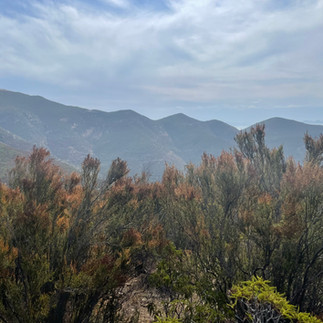"Relief" - July 2023
- liliparadisauthor
- Jan 27, 2024
- 10 min read
“I want to go home, but home is the mouth of a shark
home is the barrel of the gun
and no one would leave home
unless home chased you to the shore”
-Excerpt from “Home” by Warsan Shire
At the top of the mountain at dawn, the sun has not fully risen. The horizon is dotted with ridges like an enormous sleeping dragon, and most of the peak is still shrouded in shadows. High amongst the San Ysidro range, there is barely anyone visible that morning. Only a Border Patrol SUV, gleaming like a fat beetle in the early morning light, and an odd group that has assembled on the far side of the ridge. We stand as far away as possible from the enormous white bug, its driver behind the tinted windshield barely visible. Our group has chugged up the side of the mountain in a rugged Honda 4x4 and a Jeep, both of which have been packed to the brim with food, water, clothing, and hygiene supplies.
On the bumpy drive up we saw no one, only a couple of large beige boxes with black circles in the middle. Trail cameras, so the border patrol could watch. From where, I’m not sure. Somewhere with air conditioning. The driver of the Jeep, while carefully maneuvering the winding parkway, explains that they were once traveling up the mountain when a group of five young men suddenly came tumbling onto the road from the steep hill above, not even pausing in front of the vehicle before they continued down the sheer drop of the mountainside.
“Well, I guess they wanted to keep going,” I say. “They must know how close they are.” As soon as the words leave my mouth, however, we all glance over the mountains stretching north towards San Diego. Large, inhospitable desert hills, crawling with more border patrol beetles.
“Not as close as you’d think,” the driver says.
She tells us that it is likely we will see travelers while out in the mountains, that it is unusual not to; although barely anyone is visible, people have been moving around all night. As if on cue, we hurtle past a man sitting on a rock right on the road, head in his hands. He is so still and blends so well into the backdrop that we miss him at first, throwing the car into reverse to back up and see if he needs anything. Two of the Jeep’s passengers speak fluent Spanish, so they hop out of the car and approach the man, asking him if he needs food, water, or any other help.
He says no to food, no to help. He would love some water, though.
Another passenger walks to the trunk and busies herself with grabbing a bottle of water, a Gatorade, and a powder hydration packet, which she brings over to the man. Multiple tools are needed to combat the extreme desert heat and dehydration that has claimed the lives of thousands of migrants over the past two decades, one of the many perils people attempting to cross the border have faced. There are dangers everywhere in the desert, but unlike a snake, a coyote, a robber, or an ICE agent, escaping the heat is impossible.
The man has lifted his face slightly, his expression unreadable. The only thing clear is his exhaustion. We wish him good luck, continue down the road. He does not respond or watch us go, instead keeping his gaze fixed on the horizon.
The border patrol agent, on the other hand, is watching our caravan closely as it arrives, two vehicles full of supplies to aid the people this man has been hired to catch. The group regards him with flat expressions.
“It’s a hot one, isn’t it?” he says casually as we begin to unload. There is a grunt in affirmation from someone climbing out of the Honda, but no one comments. The agent watches us for another moment, and when it becomes clear no one is interested in talking to him, he gets in his car to begin the slow roll back down the mountain. Towards the man we passed earlier, who is now barely a speck against the landscape, completely still.
“Oh no,” mumbles one of the group leaders, peering through binoculars as the white SUV maneuvers through the rough terrain. “That guy is still there.”
As we watch, however, the agent blasts directly past the man, picking up speed as he heads to the border patrol tower stationed halfway down the mountain. We all track the car with our eyes, amazed. The man still does not move. Somehow, he has managed to avoid detection for now. He seems practiced, dressed in earth tones that match the desert and able to stay as still as the rock he leans against, sitting sideways so his heavy boots and face are angled away from the road. After the car is out of sight, the man gets up and darts across the road, back into the underbrush. Gone.
Loaded up with backpacks, the group begins the trek to our first drop. This is an area where travelers tend to congregate and rest before continuing on the journey, hidden beneath bursts of scratchy bushes that have been torched brown from the desert sun. While we walk, the driver of the Honda pickup explains that their group, along with most of the volunteers that do this sort of work, are constantly playing a game of cat and mouse with the border patrol agents who work in the same areas.
“What we’re doing isn’t illegal,” he says, picking his way along the steep, rocky trail. “But that doesn’t mean the border patrol will just let us do it. If they find our drop spots, they’ll destroy them. Food, water, everything.”
It’s such a waste, but the man explains that the border patrol simply doesn’t care. They are single-minded in their hunt. Along the path, however, we can see ample evidence that people have found the supplies before the border patrol did, using them to continue on their journey. We pass empty cans with the hard rind of food still clinging to the rim, Gatorade bottles missing their caps, ripped socks, tank tops once white and now stained the same color as the desert sand. A child’s t-shirt hangs on a tree, fluttering in the breeze. Mickey Mouse leers at us, bleached from the sun.
A culture of fear, nurtured by pundits, politicians, and random online clips of enormous groups of people overtaking the Rio Grande, have widely led people to believe that migrants fleeing to our Southern borders are young, unaccompanied men, eager to take our jobs or wreck havoc on our societies. Statistically, that is simply not the case. As of September 2023, one in four migrants traveling to the United States via the Mexico border are children; in 2022, an estimated 40,000 children crossed through Panama’s perilous Darien Gap, and that number jumped to 60,000 in the first eight months of 2023 alone.
A large majority of these immigrants, single men or otherwise, are considered asylum seekers, people who have to be “physically present” in the country as per the U.S. Center for Immigration Services in order to apply for this status in the first place. With visas, air travel, and resources unavailable to most of these travelers, what else, exactly, are they supposed to do?
I had been warned that I would likely hurt myself on the rough terrain, but I didn’t expect it to happen quite so quickly. As soon as I feel my foot slip on a rock my hand goes out instinctively, scrambling for purchase. It comes down on a jagged tree trunk sticking out of the ground. Pain shoots up my arm. Turning my hand over, I see blood running through the etching of my palm, mixing with dirt. It stings.
“Ouch,” the volunteer directly behind me says calmly. He flexes his own hands, which are covered by a pair of durable work gloves. “These are a lifesaver.”
“Noted,” I say, opening and closing my hand a few times before continuing.
Not long after, we reach the first “drop spot”, but it becomes clear that the people who stumbled upon these supplies were not migrants. Instead, the first aid kits left behind have been vandalized, torn apart, pads and tampons for women ripped open and staining the ground with white, purple, and green designs.
The group lets out a collective sigh. Someone mutters something rude, surveying the Ziploc bags that were meticulously packed by volunteers, now strewn about the landscape, the border patrol’s clear message that they just don’t want these people gone. They want them dead. Border patrol may disagree, but how else could you justify destroying supplies borne only from necessity? Large bottles of water, punctured, moisture swallowed by the dry ground. I’m reminded of the scene from the movie Holes, where the assistant warden refuses to fill Stanley Yelnet’s water bottle out of spite, instead letting it stream into the powdery dirt. A very clear punishment.
Discouraged but refusing to give up, the group continues down the increasingly steep hillside, all of us falling at one point in a comical domino effect of tumbling down the mountain. Everyone laughs, even though the girl behind me has scraped her knees and my handprint has left bloody streaks on the rocks. At the end of the day, we get to leave this inhospitable place. Not everyone is quite so lucky.
A second spot appears to us, a crossroads of sorts where thick roots and stumps twine together to create a sheltered place. A volunteer gets to work filling up a large, plastic crate with supplies, and all of us quickly follow suit. The weight on my back gets lighter and lighter with everything I pull out; bright red and blue Powerade, cans of pineapple suspended in juice, Vienna sausages in tiny blue tins. Once three black crates have been filled, signs are affixed to each, each reading in bold letters:
DO NOT DESTROY
DO NOT REMOVE
This is NOT garbage, and NOT abandoned personal property.
These are
HUMANITARIAN AID SUPPLIES
To decrease the risk of death for people using this trail; protected by federal case law, the Religious Freedom Restoration Act of 1993, and the U.S. Constitution
“Will that actually stop anyone?” I ask as we begin the trek back up the steep hillside. “The border patrol, I mean?”
One of the volunteers turns to look back at the crate, sighing. “Only ones with a conscience.”
“So, none of them,” someone deadpans behind her.
The trip back up the hillside is somehow easier than the way down, despite the steepness. You don’t feel like you’re going to fall every five seconds, and the weight of the backpack has been halved. Emboldened by the successful drop, we propel ourselves back up the mountain, pausing at the top to glare at the border patrol tower in the distance.
The group leader explains that once, the border patrol actually followed behind them on their drops, hoping to find the spots where people were resting and round them up. So, she and another volunteer had broken into a run, going as fast as possible down the side of the mountain, zigzagging and veering onto rough, narrow, paths that the officers could not follow because of their huge boots, vests, and of course, guns.
Many of these border patrol agents are just as militarized as the police forces we see increasingly peppering our cities; foreboding figures clad in tactical gear, armed to the teeth with weapons of warfare. Armed against the civilians they are sworn to protect. Armed against families in flip-flops fleeing their homes, mothers carrying their babies and unaccompanied teenagers thrust into adulthood before they are ready.
Our second drop, on the other side of the peak, is much quicker than the first, although that is partially because the slope is much steeper, and the easiest way to get down is simply crouch and let your body slide, avoiding the large rocks jutting out of the landscape. Every time I visit the desert, I’m reminded what a harsh terrain it is, that while life is abundant here, so is the possibility of harm. Each nettle, each crack in the rock, each scorching ray of sunlight or freezing-cold night could be your downfall in a place where survival constantly hangs on the balance.
The rest of supplies in our packs fill the black plastic crates, and are replaced with trash bags, which we use to clean up the remnants left behind on the way back up. Environmentally friendly, yes, but also a way to prevent border patrol from knowing where people have been finding these things. On one hand, it seems fruitless considering the border patrol watch towers are visible in the distance, and they utilize all sorts of technology like heat sensors and drones to find people, but on the other hand, it seems like the least we can do.
Finally, we are back to our caravan, the sun directly above us like an overhead lamp. In just a few short hours, the heat has turned dry and oppressive, making it hard to take a deep breath. Everyone is exhausted, filthy, and sore, many of us nursing bruises, cuts, or other minor injuries. This is only a small taste of what people traveling through these mountains experience, many of whom spend weeks traversing the harsh terrain.
These journeys are frequently followed by multiple fruitless border crossing attempts, or additional weeks or even months spent in various detention sites. The sites range from open-air detainment camps to overcrowded facilities where people are literally crammed into cages to buildings like parking garages that are crudely repurposed to hold immigrants, such as the one I witnessed while volunteering in Brownsville, Texas. In the hot July heat, with temperatures climbing above 100 F, single men and women were crammed between the concrete walls, forced to sit on the asphalt ground without food, water, mats, or pillows, reliant primarily on volunteers to make sure they fed and tended to.
It is unconscionable to me that anyone could witness scenes of this nature and not realize that this migration is and has always been borne from necessity; there is no boogeyman coming to take our jobs, our livelihoods, and our ways of life. There are only desperate people, driven out of their homelands by the violence and mayhem that resulted from multiple U.S.-backed destabilization efforts all across Central and South America.
Stocks depleted, we pile back into the two vehicles. A border patrol convoy ambles by. Somewhere amongst the desert hills, people continue to move, continue to travel, continue to cross imaginary lines in search of safety. This flow will not stop, nor will it even be slowed, by draconian and violent border policies. Only by a radical shift of safety and stability for the homelands people have been forced out of. Home can no longer be the mouth of a shark.
The drive back down the mountain is faster than the drive up. Most of us are quiet, lulled by the motion of the car and the soft murmuring of the radio. The border patrol towers grow small, tiny spirals up into the sky. The hills grow and shrink as you wind your way through them, playing tricks on your eyes. Sometimes, when the sun is bright, you can’t see much of anything at all.
If you enjoyed this piece and would like to support volunteer efforts in the desert, please consider making a donation to Borderlands Relief Collective (@borderlandsreliefcollective) or Border Kindness (@borderkindness)
Works Cited
Shire, Warsan. Conversations about Home (at a deportation centre). flipped eye, 2011.
University of Idaho. “Migrants Crossing U.S.-Mexico Border Subject to Dehydration, Death.” 2021. University of Idaho, https://www.uidaho.edu/news/news-articles/news-releases/2021-fall/121621-migrants. Accessed 30 December 2023.
Pappier, Juan. “How the Treacherous Darien Gap Became a Migration Crossroads of the Americas.” Human Rights Watch, Migration Policy Institute’s Migration Information Source, 10th October 2023, https://www.hrw.org/news/2023/10/10/how-treacherous-darien-gap-became-migration-crossroads-americas. Accessed 3rd January 2024.
UNICEF. “Number of migrant children moving across Latin America and the Caribbean hits new record amid violence, instability and climate change.” unicef.org, 7th September 2023, https://www.unicef.org/press-releases/number-migrant-children-moving-across-latin-america-and-caribbean-hits-new-record#:~:text=Meanwhile%2C%20the%20number%20of%20refugee,over%20155%2C000%20in%20FY%202022. Accessed 30 December 2023.
Holes. Written by Louis Sachar, Disney, 2003.
Martinez, Oscar. A History of Violence. Verso, 2017.
Urrera, Luis Alberto. By the Lake of Sleeping Children. First ed., Anchor Books, 1996.
U.S. Citizenship, & Immigration Services. “Asylum.” USCIS: Home, Unknown, http://uscis.gov. Accessed 12 January 2024.






You are the best, Lili
thank you for making a difference!